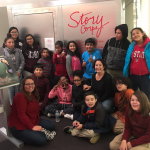Inside/Outside: Collaborating with the Cognate Collective
Connecting with the Cognate Collective
In Fall 2018, CAPE staff members were in conversation with Hannah Barco, Assistant Director of Exhibitions at SAIC’s Sullivan Galleries, about professional development for CAPE’s after-school teachers and artists. The conversation revealed an opportunity for an exciting collaboration with the Sullivan Galleries and the Cog•nate Collective, an artist group currently working in Santa Ana, CA, USA and Tijuana, BC, Mexico, that “develops research projects, public interventions, and experimental pedagogical programs in collaboration with communities across the US/Mexico border region.”
(Click here to read a conversation with the Cog•nate Collective)
CAPE’s oldest partner school, Telpochcalli Elementary in Little Village, stood out as a fantastic place to bring together the visiting Cog•nate artists, Amy Sanchez Arteaga and Misael Diaz, with students, teachers, and teaching artists working in our after-school program there. Telpochcalli is a school dedicated to integrating art and Mexican culture into the curriculum, and in the after-school classroom of teacher Erin Franzinger Barrett and teaching artist William Estrada, students were already steeped in creative explorations of their primarily Latinx community and the design and installation of public art. With further support from Barco at the Sullivan Galleries, CAPE was able to bring together our Telpochcalli team with the Cog•nate Collective and step back as the two groups explored each other’s work and formed ideas for moving forward with a collaborative project.

“Working with Cog•nate felt like they were part of our family.” -Adrian, 11 years old
Cognate Collaboration in Action
Our Telpochcalli students were excited about the Cog•nate Collective work on display at the Sullivan Galleries, especially a piece that employs mylar balloons, but were also vocal in advocating for a project centered on their collective interests, one of which was pirate radio. As a group, the students, educators, and visiting artists developed the project that was featured at CAPE’s INSIDE/OUTSIDE exhibition, in January and February 2019.

“I thought it was great. I got to make my own radio, and instead of being scared of what people might think about your voice, you have to say the truth.” -Kimberly, 10 years old
To begin the project, students conducted audio interviews with their peers and other members of the Telpochcalli community about what it means to be a part of that community. Then the students pulled from these audio recordings words that were used frequently or struck a chord with the collaborators, and then created stencils of those words. The students stenciled these words onto silver mylar balloons, which subsequently were inflated and installed around the school building. In addition to exhibiting this work at INSIDE/OUTSIDE, the Telpochcalli team expects to create more balloons and broadcast their audio recordings at Telpochcalli’s annual Art Fest at the end of the school year.
This project beautifully embodies student voice, community, collaboration, and innovation, all elements that are core to CAPE’s work in after-school spaces. We are so grateful to Hannah Barco, the Sullivan Galleries, and the Cog•nate Collective for their openness and partnership in this unique creative endeavor.

“I appreciated that Cog•nate was able to come in to a new space and work with us, with our resources and our ideas. They were able to give them a different spin.” – Erin Franzinger Barrett, Teacher
Reflecting on the Cognate Collective Collaboration
“Working collaboratively with Cog•nate as part of our class was a great way to show our students the capacity of art in affecting change in our communities by using the resources and stories already present, “reflected CAPE teaching artist William Estrada. “Cog•nate’s ability and openness to work with us as artists is a testament to their process of inclusivity and collaborative nature. […] The final works created made an impact on our students, the school, and on the way I continuously think about public engagement.”
TheCog•nate Collective added, “At Telpochcalli, [we spoke] about notions of home: what it feels like, what it sounds like, where we feel wanted, and where we feel safe. […] We ended up having rich conversations with the young students about safety, family, migration, and their aspirations and dreams for the future.[…] We were so inspired to see that the students at Telpochcalli are using art in these ways to engage, think critically and communicate about their identity and their cultural history, not just in one language, but in TWO!”






